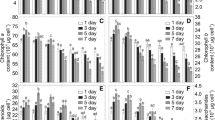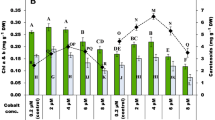Abstract
Nitrogen is a critical element for algal growth and shifting its concentration above or below the optimum concentration may have a deleterious effect on algal cells. Antioxidants are one of the important factors that protect algal cells from stresses, e.g., nitrogen stress. The purpose of this study was to evaluate the biomass, pigments, antioxidant compounds and activities of two algal species, Arthrospira platensis (prokaryotic Cyanophyta) and Pseudochlorella pringsheimii (eukaryotic Chlorophyta) under hypo- and hyper-nitrogen concentrations. In general, the increase in the nitrogen concentrations of the nutrient medium (75 and 6–18 mM for A. platensis and P. pringsheimii, respectively) led to an increase in the biomass yield, pigments and other antioxidant contents. However, this increment was reversed by further N additions. The data showed that the prokaryotic alga (A. platensis) can grow at relatively hyper-nitrogen concentrations rather than the eukaryotic one (P. pringsheimii). The antioxidant enzyme activities for the both species were significantly stimulated with the relatively lower nitrogen concentrations, while increasing the N concentrations in the media decreased the enzyme activities. Despite the superiority of A. platensis as a potent antioxidants source, both algae showed high antioxidant levels compared to the synthetic antioxidant marker (butylated hydroxytoluene, BHT).







Similar content being viewed by others
References
Allen MM (1984) Cyanobacterial cell inclusions. Annu Rev Microbiol 38:1–25
Andersen RA, Berges JA, Harrison PJ, Watanabe MM (2005) Appendix A. Recipes for freshwater and seawater media. In: Andersen RA (ed) Algal culturing techniques. Elsevier, Amsterdam, p 437
APHA (1985) American Public Health Association, Standard methods for the examination of water and waste water, 16th edn. American Public Health Association, New York
Aremu AO, Neményi M, Stirk WA, Ördög V, Staden J (2015) Manipulation of nitrogen levels and mode of cultivation are viable methods to improve the lipid, fatty acids, phytochemical content and bioactivities in Chlorella minutissima. J Phycol 51:659–669
Arumugam M, Agarwal A, Arya MC, Ahmed Z (2013) Influence of nitrogen sources on biomass productivity of microalgae Scenedesmus bijugatus. Bioresou Technol 131:246–249
Balloni W, Tomaselli L, Giovannetti L, Margheri MC (1980) Biologia fondamentale del genere Spirulina. In: Materassi R (ed.) Prospettive della Coltura di Spirulina in Italia. CNR, Roma, pp 49
Beauchamp C, Fridovich I (1971) Superoxide dismutase: improved assays and an assay applicable to acrylamide gels. Anal Biochem 44:276–287
Bennett A, Bogorad L (1973) Complementary chromatic adaptation in a filamentous blue-green alga. J Cell Biol 58:419–435
Bischoff HW, Bold HC (1963) Phycological Studies. IV. Some soil algae from Erchanted Rock and related algal species. University of Texas Publication No. 6318:32–36
Chen F (1996) High cell density culture of microalgae in heterotrophic growth. Trends Biotechnol 14:421–426
Chen F, Li HB, Wong RNS, Ji B, Jiang Y (2005) Isolation and purification of the bioactive carotenoid zeaxanthin from the microalga Microcystis aeruginosa by high-speed countercurrent chromatography. J Chromatogr A 1064:183–186
Chen CY, Kao PC, Tsai CJ, Lee DJ, Chang JS (2013) Engineering strategies for simultaneous enhancement of C-phycocyanin production and CO2 fixation with Spirulina platensis. Bioresour Technol 145:307–312
Cohen Z (1997) The chemicals of Spirulina. In: Vonshak A (ed) Spirulina platensis (Arthrospira). Taylor and Francis, London, pp 175–204
Cohen Z, Reungjitchachawali M, Angdung W, Tanticharoen M (1993) Production and partial purification of γ-linolenic acid and some pigments from Spirulina platensis. J Appl Phycol 5:109–115
Colla LM, Reinehr CO, Reichert C, Alberto J, Costa V (2007) Production of biomass and nutraceutical compounds by Spirulina platensis under different temperature and nitrogen regimes. Bioresour Technol 98:1489–1493
Converti A, Casazza AA, Ortiz EY, Perego P, Borghi MD (2009) Effect of temperature and nitrogen concentration on the growth and lipid content of Nannochloropsis oculata and Chlorella vulgaris for biodiesel production. Chem Eng Process Process Intensif 48:1146–1151
Cornet JF, Dussap CG, Gros JB (1998) Kinetics and energetics of photosynthetic micro-organisms in photobioreactors. Adv Biochem Eng/Biotechnol 59:153–224
Costa JA, Cozza KL, Oliveira L, Magagnin G (2001) Different nitrogen sources and growth responses of Spirulina platensis in microenvironments. World J Microbio Biotechnol 17:422–439
De Loura IC, Dubacq JP, Thomas JC (1987) The effects of nitrogen deficiency on pigments and lipids of cyanobacteria. Plant Physiol 83:838–843
Demming-Adams B, Adams WW (2002) Antioxidants in photosynthesis and human nutrition. Science 298:2149–2153
Dytham C (1999) Choosing and using statistics: a biologist’s guide. Blackwell Science Ltd., London, pp 147
Inokuchi R, Kuma KI, Miyata T, Okada M (2002) Nitrogen-assimilating enzymes in land plants and algae: phylogenic and physiological perspectives. Physiol Plant 116:1–11
Jimenez-Escrig A, Jimenez-Jimenez I, Pulido R, Saura-Calixto F (2001) Antioxidant activity of fresh and processed edible seaweeds. J Sci Food Agric 81:530–534
Kar M, Mishra D (1976) Catalase, peroxidase and polyphenol oxidase activities during rice leaf senescence. Plant Physiol 57:315–319
Kim D, Jeond S, Lee C (2003) Antioxidant capacity of phenolic phytochemicals from various cultivars of plums. Food Chem 81:321–326
Kopsell DA, Kopsell DE, Curran-Celentano J (2007) Carotenoid pigments in kale are influenced by nitrogen concentration and form. J Sci Food Agric 87:900–907
Kuda T, Tsunekawa M, Hishi T, Araki Y (2005) Antioxidant properties of dried ‘kayamo-nori’, a brown alga Scytosiphon lomentaria (Scytosiphonales, Phaeophyceae). Food Chem 89:617–622
Kumar M, Kumari P, Gupta V, Reddy CRK, Jha B (2010) Biochemical responses of red alga Gracilaria corticata (Gracilariales, Rhodophyta) to salinity induced oxidative stress. J Exp Mar Biol Ecol 391:27–34
Lee RE (2008a) The prokaryotic algae. In: Lee (ed) Phycology, 4th edn. Cambridge University Press, USA, pp 31–74
Lee RE (2008b) Chlorophyta. In: Lee (ed) Phycology, 4th edn. Cambridge University Press, USA, pp 139–237
Leong LP, Shui G (2002) An investigation of antioxidant capacity of fruits in Singapore markets. Food Chem 76:69–375
Leopoldini M, Marino T, Russo N, Toscano M (2004) Antioxidant properties of phenolic compounds: H-atom versus electron transfer mechanism. J Phys Chem A 108:4916–4922
Li Y, Horsman M, Wang B, Wu N, Lan CQ (2008) Effects of nitrogen sources on cell growth and lipid accumulation of green alga Neochloris oleoabundans. Appl Microbiol Biotechnol 81:629–636
Lowery OH, Rosebrough NJ, Farr AL, Randall RJ (1951) Protein measurement with the Folin phenol reagent. J Biochem 193:256–275
Macías-Sánchez MD, Mantell C, Rodríguez M, de la Ossa EM, Lubián LM, Montero O (2007) Supercritical fluid extraction of carotenoids and chlorophyll a from Synechococcus sp. J Super Fluids 39:323–329
Mallick N (2004) Copper-induced oxidative stress in the chlorophycean microalga Chlorella vulgaris: response of the antioxidant system. J Plant Physiol 161:591–597
Menéndez M, Herrera-Silveira J, Comín FA (2002) Effect of nitrogen and phosphorus supply on growth, chlorophyll content and tissue composition of the macroalga Chaetomorpha linum (O.F. Mull), Kutz, in a Mediterranean Coastal Lagoon. Sci Mar 66:355–364
Metzner H, Rau H, Sénger H (1965) Untersuchungen zur synchronisierbarkiet einzelner pigmangel–mutanten von Chlorella. Planta 65:186–194
Michiels C, Raes M, Toussaint O, Remacle J (1994) Importance of Se-glutathione peroxidase, catalase, and Cu/Zn-SOD for cell survival against oxidative stress. Free Radic Biol Med 17:235–248
Miyake C, Michihata F, Asada K (1991) Scavenging of hydrogen peroxide in prokaryotic and eukaryotic algae: acquisition of ascorbate peroxidase during evolution of cyanobacteria. Plant Cell Physiol 32:33–43
Moure A, Domínguez H, Parajó JC (2006) Antioxidant properties of ultrafiltration-recovered soy protein fractions from industrial effluents and their hydrolysates. Process Biochem 41:447–456
Nakano Y, Asada K (1989) Hydrogen peroxide is scavenged by ascorbate-specific peroxidase in spinach chloroplasts. Plant Cell Physiol 22:867–880
Oboh G, Puntel RL, Rocha JBT (2007) Hot pepper (Capsicum annuum, Tepin and Capsicum chinese, Habanero) prevents Fe2+-induced lipid peroxidation in brain: in vitro. Food Chem 102:178–185
Parjikolaei BR, Kloster L, Bruhn A, Rasmussen MB, Fretté X, Christensen KV (2013) Effect of light quality and nitrogen availability on the biomass production and pigment content of Palmaria palmata (Rhodophyta). Chem Eng Trans 32:967–972
Perez-Garcia O, Bashan Y (2015) Microalgal heterotrophic and mixotrophic culturing for bio-refining: from metabolic routes to techno-economics. In: Prokop A, Bajpai R, Zappi M (eds) Algal biorefineries, vol. 2: Products and Refinery Design. Springer International Publishing, Switzerland, pp 61–131
Piorreck M, Baasch KH, Pohl P (1984) Biomass production, total protein, chlorophylls, lipids and fatty acids of freshwater green and blue-green algae under different nitrogen regimes. Phytochemistry 23:207–216
Puntel RL, Nogueira CW, Rocha JBT (2005) Krebs cycle intermediates modulate thiobarbituric acid reactive species (TBARS) production in rat brain in vitro. Neurochem Res 30:225–235
Raven RH, Evert RF, Eichhorn SE (2005) Biology of plants. WH Freeman and Company Publications, NY
Rodriguez-Garcia I, Guil-Guerrero JL (2008) Evaluation of the antioxidant activity of three microalgal species for use as dietary supplements and in the preservation of foods. Food Chem 108:1023–1026
Rodríguez-Sánchez R, Ortiz-Butrón R, Blas-Valdivia V, Hernández-García A, Cano-Europa E (2012) Phycobiliproteins or C-phycocyanin of Arthrospira (Spirulina) maxima protect against HgCl2-caused oxidative stress and renal damage. Food Chem 135:2359–2365
Sánchez-Moreno C, Larrauri JA, Saura-Calixto F (1998) A procedure to measure the antiradical efficiency of polyphenols. J Sci Food Agric 76:270–276
Sigaud-Kutner TCS, Neto AMP, Pinto E, Colepicolo P (2005) Diel activities of antioxidant enzymes, photosynthetic pigments and malondialdehyde content in stationary-phase cells of Tetraselmis gracilis (Prasinophyceae). Aquat Bot 82:239–249
Spitz TT, Bergman M, Moppes D, Grossman S, Arad MS (2005) Antioxidant activity of the polysaccharide of the red microalga Porphyridium sp. J Appl Phycol 17:215–222
Spolaore P, Joannis-Cassan C, Duran E, Isambert A (2006) Commercial applications of microalgae. J Biosci Bioeng 101:87–96
Tokusoglu Ö, Ünal MK (2003) Biomass Nutrient profiles of three microalgae: Spirulina platensis, Chlorella vulgaris, and Isochrisis galbana. J Food Sci 68:1144–1148
Tomaselli L, Giovannetti L, Margheri MC (1981) On the mechanism of trichome breakage in Spirulina platensis and S. maxima. Ann Microbiol 31:27–34
Vonshak A (1997a) Spirulina platensis (Arthrospira): physiology, cell-biology and biotechnology, 1st edn. Taylor and Francis Ltd., London
Vonshak A (1997b) Appendices. In: Vonshak A (ed) Spirulina platensis (Arthrospira): physiology, cell-biology and biotechnology, 1st edn. Taylor and Francis Ltd., London, pp 218–219
Wang J, Zhao M, Zhao Q, Jiang Y (2007) Antioxidant properties of papain hydrolysates of wheat gluten in different oxidation systems. Food Chem 101:1658–1663
Wu LC, Ho JA (2007) Antioxidative and hepatoprotective effects of Spirulina. In: Gershwin ME, Belay A (eds) Spirulina in human nutrition and health. CRC Press, Boca Raton, pp 119–152
Wu LC, Ho JA, Shieh MC, Lu IW (2005) Antioxidant and antiproliferative activities of Spirulina and Chlorella water extracts. J Agric Food Chem 53:42707–44212
Yen GC, Chang YC, Su SW (2003) Antioxidant activity and active compounds of rice koji fermented with Aspergillus candidus. Food Chem 83:49–54
Yildirim A, Mavi A, Kara A (2001) Determination of antioxidant and antimicrobial activities of Rumex crispus L. extracts. J Agric Food Chem 49:4083–4089
Zhu QY, Hackman RM, Ensunsa JL, Holt RR, Keen CL (2002) Antioxidative activities of Oolong tea. J Agric Food Chem 50:6929–6934
Acknowledgments
The author thanks Prof. Dr. Yassin El-Ayouty for support and encouragement, Dr. Chris Deduke and Maged Ismaiel for writing assistance.
Author information
Authors and Affiliations
Corresponding author
Additional information
Communicated by K Apostol.
Rights and permissions
About this article
Cite this article
Ismaiel, M.M.S. Effect of nitrogen regime on antioxidant parameters of selected prokaryotic and eukaryotic microalgal species. Acta Physiol Plant 38, 154 (2016). https://doi.org/10.1007/s11738-016-2170-2
Received:
Revised:
Accepted:
Published:
DOI: https://doi.org/10.1007/s11738-016-2170-2




